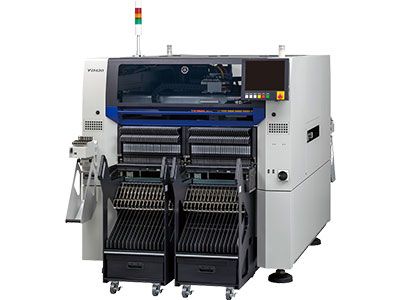Surface Mount Technology (SMT) machines are at the heart of modern electronics manufacturing. Unlike older through-hole methods, SMT involves mounting electronic components directly onto the surface of printed circuit boards (PCBs), which allows for greater automation, higher component density, faster production, and smaller, more reliable devices. These machines—pick-and-place, reflow ovens, inspection systems—work together to deliver precision and speed in assembling everything from consumer gadgets to industrial systems.
As demand for miniaturization, IoT devices, and advanced consumer electronics grows, SMT machines are evolving rapidly. New developments in vision systems, accuracy, speed (components per hour), software integration, and flexibility are enabling manufacturers to handle complex boards, fine-pitch components (such as 01005), mixed technologies, and frequent product changes. Understanding SMT machines, their working process, and how to choose the right equipment is essential for any electronics manufacturer aiming for quality, efficiency, and competitiveness.

Importance of SMT Machines in Electronics Production
-
Allow very high throughput with consistent quality, reducing manual labor and associated errors.
-
Support flexibility: ability to handle varying board sizes, different component types, and rapid changeovers between product designs.
-
Enable miniaturization and high component density, critical for modern electronics that are compact and smart.
-
Improve reliability of solder joints and performance, especially with precise placement, prints, and proper reflow.
Key Types of SMT Machines & Components
-
Pick-and-Place Machines: Automatically pick components from feeders and accurately place them onto PCBs. Accuracy and speed (components per hour, or CPH) are key specs.
-
Solder Paste Printers: Apply solder paste to PCB pads through stencils, critical for ensuring correct solder volume and alignment.
-
Reflow Ovens: Heat the board to melt the solder paste and form electrical/mechanical connections, following controlled temperature profiles.
-
Automated Inspection Systems (AOI / SPI / AXI): Check for defects such as misalignment, solder bridges, tombstoning, insufficient solder, etc. Crucial for quality control.
How to Choose SMT Machines: Key Criteria
-
Throughput / Production Volume: Decide how many boards per hour you need; high-speed machines cost more but pay off in high volume settings.
-
Placement Accuracy & Precision: Especially important for fine-pitch components; errors lead to defects and rework.
-
Component Variety Compatibility: Your machines should support various component sizes, types (chip, ICs, connectors), fine pitch, etc.
-
Software & Automation Features: Vision systems, software for feeder management, error correction, integration with MES or data collection are increasingly important.
-
Flexibility & Changeover: For manufacturers who handle multiple products, fast changeover, modular heads or nozzles, multi-lane capability matter.
-
Maintenance, Vendor Support & Total Cost: Looks beyond purchase price—consider reliability, spare parts, calibration, service, energy consumption.
SMT Production Process: Step-by-Step
| Step | What Happens | Why It Matters |
|---|---|---|
| Stencil / Paste Printing | Solder paste is applied to pads via stencil | Proper paste application ensures strong joints and prevents defects. |
| Component Placement | Pick-and-place machines mount components | Speed, accuracy, and correct orientation are essential for function. |
| Reflow Soldering | Heating to melt solder and create connections | The profile must match components to avoid heat damage or cold solder joints. |
| Inspection (AOI / SPI / AXI) | Automated checks for defects visually or via X-ray | Early defect detection saves cost, improves yields. |
| Testing / Functional Check | Electrical or functional testing of assembled PCBs | Ensures product works as intended before shipping. |
Trends & Innovations in SMT Machines (2024-2025)
-
Increasing precision for ultra fine-pitch components such as 01005 and below.
-
Enhanced vision systems and AI for real-time defect detection, self-alignment, and feedback loop adjustment to improve yield.
-
More modular pick-and-place machines enabling flexibility and scalability for mixed volume production.
-
Stronger software and connectivity (IoT, MES, data analytics) for traceability, monitoring, and predictive maintenance.
-
Green manufacturing: reducing waste of solder paste, power consumption, and environmental impact of materials.
FAQs
Q1. What does “CPH” mean in the context of SMT machines?
CPH means “components per hour” — a measure of how many parts a machine can place in an hour. Higher CPH is important for high-volume manufacturing.
Q2. What is fine pitch or ultra fine pitch components?
These are components with very small spacing between pads (e.g., 0.5 mm, 0.4 mm, or smaller). They require more precision and better vision systems to place accurately.
Q3. How critical is solder paste printing?
Very critical. If the solder paste is poorly deposited (too much, too little, or misaligned), it causes many defects downstream: insufficient solder joints, bridging, tombstoning, etc.
Q4. Can small manufacturers benefit from SMT machines?
Yes. Even for low to mid volume work, modular pick-and-place machines, entry-level inspection tools, and flexible setups allow small manufacturers to adopt SMT with good cost efficiency.
Q5. How often should SMT equipment be calibrated and inspected?
Regularly—during setup, periodically during production cycles, and after major maintenance. Vision systems, placement heads, feeders, and reflow oven profiles all need calibration for consistent performance.
Conclusion
SMT machines are revolutionising electronics production by enabling automation, higher component density, faster assembly, and better reliability. Choosing the right SMT machine—including pick-and-place, printers, reflow ovens, and inspection systems—depends on the production volume, component complexity, speed, accuracy, and flexibility required. With ongoing innovations in vision, AI, modularity, software integration, and green practices, SMT technology is becoming more adaptable and powerful. For manufacturers aiming to stay competitive, investing in the right SMT machinery and process controls delivers quality, efficiency, and long-term value.